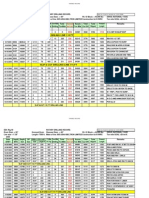Inflow Test
Inflow Test
Uploaded by
R.GCopyright:
Available Formats
Inflow Test
Inflow Test
Uploaded by
R.GOriginal Description:
Copyright
Available Formats
Share this document
Did you find this document useful?
Is this content inappropriate?
Copyright:
Available Formats
Inflow Test
Inflow Test
Uploaded by
R.GCopyright:
Available Formats
https://www.scribd.
com/document/291399354/Ca
sing-Tubing-Positive-and-Negative-Tests-7in-
TOL-Inflow-Test-Program
https://blog.odfjellwellservices.com/inflow-
negative-testing-why-and-how
INFLOW TEST
Inflow tests are generally carried out to verify if there is communication with the formation through the
casing, a liner lap or past a cement plug (bridge plug).
Most of the applications are in connection with testing or squeezed off perforations and casing leaks, testing
liner-laps, float shoes and float collars, cement plugs and bridge plugs.
An inflow test is performed by reducing the hydrostatic head above the item to be tested by circulating to a
lighter fluid.
Procedure for Circulating to Lighter Fluids (Diesel etc.)
1. RUN retrievable packer with circulating valve, safety joint and short tail on drillpipe, to depth to be
advised by Operations Engineer.
2. SET retrievable packer at advised depth and test annulus with 1000 psi in order to check that packer
is properly sealing and that the tool assembly is functioning properly before RIH any further.
3. Generally, the retrievable packer should be set at some 50 ft above the interval to be tested (or 50 ft
above TOL) in order to minimise any possible influx. OBTAIN prior approval from the Head of
Onshore/Offshore Operations for inflow testing during the hours of darkness.
4. CIRCULATE the drillpipe to a lighter fluid until the required drawdown is accomplished. (An air
cushion may be used)
5. After having circulated the well to achieve the required drawdown, PERFORM the inflow test on the
well for 15minutes as detailed in the Drilling Programme.
6. REVERSE well to completion fluid.
7. UNSEAT retrievable packer. CIRCULATE and OBSERVE well dead.
8. POOH and L/D retrievable packer.
Interpreting Inflow Test Results
The Horner Plot method should be used for interpreting inflow tests to confirm the integrity of liner laps for
over pressured gas wells. Traditional methods are often ambiguous and require unnecessary long rig time.
Traditional Interpretation method
The mechanical integrity of e.g. liner laps can be tested by creating a underbalanced situation over the zone
of interest. This is usually done by displacing the well to water. Once the well has been displaced to water,
the fluid returns are monitored for a duration of say 4 hrs. This back flow from the well is caused either by
thermal expansion, or an influx into the well bore (leak) and thermal expansion
The observed flow rates are plotted against a time scale allow to determine if the situation is one with both
an influx and thermal expansion or with temperature effects only. In order to positive
You might also like
- Red Baron General CatalogDocument40 pagesRed Baron General CatalogKaleem Ullah100% (1)
- Bowen Fishing Methods PDFDocument19 pagesBowen Fishing Methods PDFJorge Gomez Portilla100% (1)
- IPTC-20324-MS Force Calculation With Oil Well Packer: A RevisitDocument16 pagesIPTC-20324-MS Force Calculation With Oil Well Packer: A Revisitabodolkuhaa100% (3)
- Detailed Rolling MillsDocument167 pagesDetailed Rolling MillsMd.zubairNo ratings yet
- Coiled Tubing Operations at a Glance: What Do You Know About Coiled Tubing Operations!From EverandCoiled Tubing Operations at a Glance: What Do You Know About Coiled Tubing Operations!Rating: 5 out of 5 stars5/5 (2)
- Liner Lap TestingDocument1 pageLiner Lap TestingEmad JamshidiNo ratings yet
- Stuck Pipe Freeing WorksheetDocument1 pageStuck Pipe Freeing WorksheetAdeel NenseyNo ratings yet
- Overpull CalculatorDocument5 pagesOverpull Calculatorzaideid50% (2)
- Liner Hanger Design and Operations: Abdulkadir TEKİN InstructorDocument53 pagesLiner Hanger Design and Operations: Abdulkadir TEKİN Instructoravula43No ratings yet
- AHC Packer H012992 PDFDocument2 pagesAHC Packer H012992 PDFAhmed Mamdouh100% (1)
- Cup Tester Torque ValuesDocument3 pagesCup Tester Torque ValuesDorin Radu100% (2)
- Squeeze Cementing Placement TechniquesDocument3 pagesSqueeze Cementing Placement TechniqueszapspazNo ratings yet
- Dog Leg Severity CalculationDocument30 pagesDog Leg Severity CalculationChristian LianNo ratings yet
- Parveen Well Head PDFDocument25 pagesParveen Well Head PDFRatnakar PatilNo ratings yet
- Esp Running ProceduresDocument12 pagesEsp Running ProceduresAhmedMohsenNo ratings yet
- Superior Packer Setting ProceduereDocument10 pagesSuperior Packer Setting ProcedueretarangtusharNo ratings yet
- Liner Procedure 5.5 ExamDocument3 pagesLiner Procedure 5.5 ExamOmar Eduardo Sanchez GodinezNo ratings yet
- Wellbore Sidetracking GuidelinesDocument5 pagesWellbore Sidetracking Guidelinesmadonnite3781No ratings yet
- Drilling EquipmentDocument63 pagesDrilling EquipmentYudha negaraNo ratings yet
- 13 38 Casing Preparation and Running ChecklistDocument3 pages13 38 Casing Preparation and Running ChecklistrajkumarfNo ratings yet
- Conventional Sucker Rod Running Procedure SWIDocument6 pagesConventional Sucker Rod Running Procedure SWIFaruq. MechanicNo ratings yet
- Jars and Accelerators.Document10 pagesJars and Accelerators.gaddasalimNo ratings yet
- Back OffDocument3 pagesBack OffSasan AbbasiNo ratings yet
- Casing Running and Drilling ToolsDocument33 pagesCasing Running and Drilling Toolsfffggg777No ratings yet
- Squeeze Remedial CementingDocument4 pagesSqueeze Remedial CementingMahesh MahajanNo ratings yet
- Mechanical Setting Procudere of CR & Bridge PlugDocument7 pagesMechanical Setting Procudere of CR & Bridge PlugChandra FadhillahNo ratings yet
- Product Technical Data Manual April 2012 TOPCODocument181 pagesProduct Technical Data Manual April 2012 TOPCOJosé Del Orbe García100% (4)
- Bha HandlingDocument7 pagesBha HandlingAbdul Hameed OmarNo ratings yet
- 3 - Running The CompletionDocument58 pages3 - Running The CompletionDavide BoreanezeNo ratings yet
- Tom Mile Calculation PDFDocument6 pagesTom Mile Calculation PDFBeni N SoloNo ratings yet
- Rig DesginDocument25 pagesRig DesginImam Pranadipa100% (2)
- Liner Tie-Back StringDocument1 pageLiner Tie-Back StringYougchu LuanNo ratings yet
- Packer ForceDocument68 pagesPacker ForceparthameisterNo ratings yet
- Casing Cutting Procedure - WFDDocument5 pagesCasing Cutting Procedure - WFDprateek132106No ratings yet
- Corpro Coring PresentationDocument80 pagesCorpro Coring PresentationemmanuelNo ratings yet
- Trip Sheet For RigDocument1 pageTrip Sheet For Rigankurume1984100% (1)
- Well-Head SelectionDocument13 pagesWell-Head Selectionmghareeb100% (3)
- Documents - MX How To Run and Cement Liners Part 1.PDFDocument6 pagesDocuments - MX How To Run and Cement Liners Part 1.PDFKhaledFekairNo ratings yet
- Completion & Workover.Document9 pagesCompletion & Workover.msu6383No ratings yet
- Drilling Tools - 1Document269 pagesDrilling Tools - 1berrouiNo ratings yet
- Running Procedure For Drilling JarsDocument3 pagesRunning Procedure For Drilling JarsVincetine AlmazanNo ratings yet
- Tie Back Liner RunDocument3 pagesTie Back Liner RunkangrassNo ratings yet
- Ton Miles Calculator User ManualDocument19 pagesTon Miles Calculator User Manualibrh42No ratings yet
- Gas Lift MandrelsDocument20 pagesGas Lift MandrelsJenishlalchetaNo ratings yet
- Drilling Formulas Calculation Sheet Verson 1.5Document199 pagesDrilling Formulas Calculation Sheet Verson 1.5Vidit GuptaNo ratings yet
- Alternate Path Technology: Higher Production From Gravel-Packed WellsDocument8 pagesAlternate Path Technology: Higher Production From Gravel-Packed WellsNatasha Perez EscobarNo ratings yet
- 13 3-8" Cementing Program ChecklistDocument2 pages13 3-8" Cementing Program ChecklistYougchu LuanNo ratings yet
- TCP Perforating ProgrammeDocument3 pagesTCP Perforating ProgrammeYougchu LuanNo ratings yet
- HydraQuacker Double Acting Hydraulic Drilling Jar.Document93 pagesHydraQuacker Double Acting Hydraulic Drilling Jar.Muhammad Zikry Alfindy Haz100% (1)
- Packer Setting MechanismDocument3 pagesPacker Setting MechanismYougchu Luan67% (3)
- Casing Design PDFDocument41 pagesCasing Design PDFfabianandres23100% (4)
- 8209-Models D, DA, DAB and DB Retainer Production Packers FoDocument12 pages8209-Models D, DA, DAB and DB Retainer Production Packers Fodanonnino0% (1)
- Ton MileDocument106 pagesTon MileAbdul Hameed OmarNo ratings yet
- Liner Hanger Systems Data SheetDocument1 pageLiner Hanger Systems Data SheetJhonathan MirandaNo ratings yet
- Use of Coiled Tubing As A Velocity StringDocument3 pagesUse of Coiled Tubing As A Velocity StringMark Johnson100% (1)
- Omni DTDocument2 pagesOmni DTCHEKOUFI Said100% (1)
- Measurement While Drilling: Signal Analysis, Optimization and DesignFrom EverandMeasurement While Drilling: Signal Analysis, Optimization and DesignNo ratings yet
- Wave Propagation in Drilling, Well Logging and Reservoir ApplicationsFrom EverandWave Propagation in Drilling, Well Logging and Reservoir ApplicationsNo ratings yet
- Modern Borehole Analytics: Annular Flow, Hole Cleaning, and Pressure ControlFrom EverandModern Borehole Analytics: Annular Flow, Hole Cleaning, and Pressure ControlNo ratings yet
- Why Intelligent Coiled Tubing?: © 2010 Baker Hughes Incorporated. All Rights Reserved. 4Document1 pageWhy Intelligent Coiled Tubing?: © 2010 Baker Hughes Incorporated. All Rights Reserved. 4R.GNo ratings yet
- Well Control EquipemntDocument1 pageWell Control EquipemntR.GNo ratings yet
- Electricity Bill - History PDFDocument1 pageElectricity Bill - History PDFR.GNo ratings yet
- IADC Rig Pass/PEC Orientation Training Course OutlineDocument1 pageIADC Rig Pass/PEC Orientation Training Course OutlineR.GNo ratings yet
- Volumetric Well Control - When It Will Be Used - Drilling Formulas and Drilling Calculations PDFDocument17 pagesVolumetric Well Control - When It Will Be Used - Drilling Formulas and Drilling Calculations PDFR.GNo ratings yet
- Respirator Fit TestingDocument3 pagesRespirator Fit TestingR.GNo ratings yet
- Volumetric Well Control Method-Drilling FormulaeDocument19 pagesVolumetric Well Control Method-Drilling FormulaeR.GNo ratings yet
- RP64 DiverterDocument76 pagesRP64 DiverterRobertok1234No ratings yet
- Logging / Measurement While Drilling: Vaoqana Ko Daorana Samlaokna (LWD/MWD)Document10 pagesLogging / Measurement While Drilling: Vaoqana Ko Daorana Samlaokna (LWD/MWD)R.GNo ratings yet
- Acteon Kevin BurtonDocument16 pagesActeon Kevin BurtonR.GNo ratings yet
- BallooningDocument3 pagesBallooningR.GNo ratings yet
- Reward ManagementDocument13 pagesReward Managementsmashh100% (1)
- ConsumerismDocument16 pagesConsumerismTamal ChattarajNo ratings yet
- ANCC Kumaon OrientationDocument13 pagesANCC Kumaon Orientationbhumit bamelNo ratings yet
- 67 EAQEC MinutesDocument18 pages67 EAQEC MinutesMuhammad MudassarNo ratings yet
- Aluminum 2024 t351 Sheet SuppliersDocument13 pagesAluminum 2024 t351 Sheet Supplierssanghvi overseas incNo ratings yet
- Scientific Project 6 Semana 3Document1 pageScientific Project 6 Semana 3Jhon CobeñaNo ratings yet
- ERKE Group, SMW Method and SEMW Soil Mixing EquipmentsDocument3 pagesERKE Group, SMW Method and SEMW Soil Mixing EquipmentserkegroupNo ratings yet
- Case Study Test PalnDocument2 pagesCase Study Test PalnajayNo ratings yet
- Microbial Inoculants in Sustainable Agricultural Productivity Vol. 1Document354 pagesMicrobial Inoculants in Sustainable Agricultural Productivity Vol. 1PekkaSwamplordNo ratings yet
- 2002 Tech ChariDocument12 pages2002 Tech ChariRajeshkumar ElangoNo ratings yet
- Eco Tourism INDocument57 pagesEco Tourism INPixel Digital serviceNo ratings yet
- الاینمنت کولر های هوایی PDFDocument9 pagesالاینمنت کولر های هوایی PDFFatima NusserNo ratings yet
- KALVI KADAL 12th English Quick Refernce Material For Public Exam WWW - Kalvikadal.inDocument103 pagesKALVI KADAL 12th English Quick Refernce Material For Public Exam WWW - Kalvikadal.in2105 J. RajeshwariNo ratings yet
- Ceramic BearingsDocument9 pagesCeramic Bearingssureshnfcl100% (1)
- Unit٣Document5 pagesUnit٣SHiemaa SHiemaaNo ratings yet
- Technical Assistance PlanDocument3 pagesTechnical Assistance PlanMarites Del Valle Villaroman94% (16)
- Zero Defects - WhyDocument9 pagesZero Defects - WhyKumaravel SivaNo ratings yet
- QSM Finals 2 - Service Excellence - Leading The Way To WowDocument14 pagesQSM Finals 2 - Service Excellence - Leading The Way To WowCasas MhelbbieNo ratings yet
- Dera Bugti 2Document57 pagesDera Bugti 2munir HussainNo ratings yet
- Rheological Behaviour of Nickel LateriteDocument13 pagesRheological Behaviour of Nickel LateriteальNo ratings yet
- LR-TB5000 IM 96M12739 GB WW 1034-3a: Related TitlesDocument30 pagesLR-TB5000 IM 96M12739 GB WW 1034-3a: Related Titlessink or swimNo ratings yet
- SPEC of Pipes For ShipbuildingDocument13 pagesSPEC of Pipes For ShipbuildingShajahan ShagulNo ratings yet
- GSLN Advisory Plat Reactor External Nozzle 20161128 Rev1Document30 pagesGSLN Advisory Plat Reactor External Nozzle 20161128 Rev1SagarBabuNo ratings yet
- Slurry Pump Effects On Distribution and Point of Use CMP SystemsDocument28 pagesSlurry Pump Effects On Distribution and Point of Use CMP SystemsAlwin WanNo ratings yet
- Ips Led Monitor (Led Monitor) : Owner'S ManualDocument36 pagesIps Led Monitor (Led Monitor) : Owner'S ManualSupuran RichardoNo ratings yet
- 15 - Electrical QuantitiesDocument20 pages15 - Electrical QuantitiesEdgardo Leysa100% (1)
- Spray DryingDocument29 pagesSpray DryingTamzidul AlamNo ratings yet
- Chesson & Munse (1964) - Studies of The Behavior of High-Strength Bolts & Bolted Joints - U of IllinoisDocument82 pagesChesson & Munse (1964) - Studies of The Behavior of High-Strength Bolts & Bolted Joints - U of Illinoiswackokid0% (1)
- Meaning of Deviance BehaviorDocument18 pagesMeaning of Deviance BehaviorsaniyaNo ratings yet




































































































